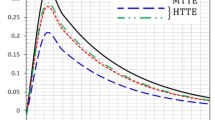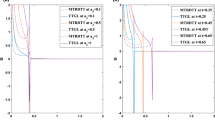Abstract
The temperature variation within two elastic bodies in perfect thermoelastic contact may cause the contact area to become convex and hence lead to a reduction in the size of the contacting surface. In receding thermoelastic contact problems, the final size of the contact zone is independent of the applied loads, being only affected by the thermomechanical properties of the solids. However, the final size of the contact zone can also be affected by the conductive and convective boundary conditions at the separation zones of the contacting surfaces. In those regions, the heat flux is a function of the separation between the solids, so the thermal and the thermoelastic problems are highly coupled. For this reason, this work studies the three-dimensional receding thermomechanical contact problem under conductive and convective boundary conditions at the interstitial zones of the contact area. After the validation of the numerical scheme presented to solve this problem, several examples are presented and discussed in detail. The results reveal that conductive and convective interstitial boundary conditions have a significant effect not only on the size of the contact zone, but also on the resulting tractions, temperature and heat flux distributions.























Similar content being viewed by others
References
Dundurs, J.: Distorsion of a body caused by free thermal expansion. Mech. Res. Commun. 1(3), 121–124 (1974). https://doi.org/10.1016/0093-6413(74)90001-9
Comninou, M., Dundurs, J.: On the barber boundary conditions for thermoelastic contact. J. Appl. Mech. 46, 849–853 (1979)
Barber, J.R.: Indentation of the semi-infinite elastic solid by a hot sphere. Int. J. Mech. Sci. 15, 813–819 (1973)
Dundurs, J., Stippes, M.: Role of elastic constants in certain contact problems. J. Appl. Mech. 37, 965–970 (1970)
Comez, I., Birinci, A., Erdol, R.: Double receding contact problem for a rigid stamp and two elastic layers. Eur. J. Mech. A Solids 23, 301–309 (2004)
Kahya, V., Ozsahin, T.S., Birinci, A., Erdol, R.: A receding contact problem for an anisotropic elastic medium consisting of a layer and a half plane. Int. J. Solids Struct. 44, 5695–5710 (2007)
Ahn, Y.J., Barber, J.R.: Response of frictional receding contact problems to cyclic loading. Int. J. Mech. Sci. 50, 1519–1528 (2008)
Rhimi, M., El-Borgi, S., Ben Said, W., Ben Jemaa, F.: A receding contact axisymmetric problem between a functionally graded layer and a homogeneous substrate. Int. J. Solids Struct. 46(20), 3633–3642 (2009). https://doi.org/10.1016/j.ijsolstr.2009.06.008
Yan, J., Li, X.: Double receding contact plane problem between a functionally graded layer and an elastic layer. Eur. J. Mech. A Solids 53, 143–150 (2015). https://doi.org/10.1016/j.euromechsol.2015.04.001
Parel, K.S., Hills, D.A.: Frictional receding contact analysis of a layer on a half-plane subjected to semi-infinite surface pressure. Int. J. Mech. Sci. 108–109, 137–143 (2016)
Yilmaz, K.B., Comez, I., Yildirim, B., Güler, M.A., El-Borgi, S.: Frictional receding contact problem for a graded bilayer system indented by a rigid punch. Int. J. Mech. Sci. 141, 127–142 (2018)
Lopes, J.P., Hills, D.A.: The axisymmetric frictional receding contact of a layer pressed against a half-space by pressure outside a disk. Eur. J. Mech. A Solids 77, 103787 (2019)
Lopes, J.P., Hills, D.A.: The axisymmetric frictional receding contact of a layer pressed against a half-space by a point force. Int. J. Solids Struct. 171, 47–53 (2019)
Wriggers, P., Zavarise, G.: Thermomechanical contact—a rigorous but simple numerical approach. Comput. Struct. 46(1), 47–53 (1993)
Johansson, L., Klarbring, A.: Thermoelastic frictional contact problems: modelling, finite element aproximantion and numerical realization. Comput. Methods Appl. Mech. Eng. 105, 181–210 (1993)
Strömberg, N.: Finite element treatment of two-dimensioanl thermoelastic wear problems. Comput. Methods Appl. Mech. Eng. 177, 441–455 (1999)
Ireman, P., Klarbring, A., Strömberg, N.: Finite element algorithms for thermoelastic wear problems. Eur. J. Mech. A Solids 21, 423–440 (2002)
Strömberg, N.: An Eulerian approach for simulating frictional heating in disc-pad systems. Eur. J. Mech. A Solids 30, 673–683 (2011)
Bouzinov, P.A., Patunso, D., Bathe, K.-J.: A finite element procedure for the analysis of thermomechanical solids in contact. Comput. Struct. 75, 551–573 (2000)
Hüeber, S., Wohlmut, B.I.: Thermo-mechanical contact problems on non-matching meshes. Comput. Methods Appl. Mech. Eng. 198, 1338–1350 (2009)
Ovcharenko, A., Yang, M., Chun, K., Talke, F.E.: Transient therm-mechanical contact of an impacting sphere on a moving flat. J. Tribol. 133, 031404 (2011)
Seitz, A., Wall, W.A., Popp, A.: Nitsche’s method for finite deformation thermomechanical contact problems. Comput. Mech. 63, 1091–1110 (2019)
Chan, S.K., Tuba, I.S.: A finite element method for contact problems of solid bodies—1: theory and validation. Int. J. Mech. Sci. 13, 615–625 (1971)
Francavilla, A., Zienkiewicz, O.C.: A note on numerical computation of elastic contact problems. Int. J. Numer. Methods Eng. 19, 913–924 (1975)
Jing, H.S., Liao, M.L.: An improved finite element scheme for elastic contact problems with friction. Comput. Struct. 35(5), 571–578 (1990)
Aliabadi, F.M.H.: The Boundary Element Method: Applications in Solids and Structures, vol. 2. Wiley, Chichester (2002)
Man, K.W., Aliabadi, M.H.: BEM frictional contact analysis: modelling considerations. Eng. Anal. Bound. Elem. 11, 77–85 (1993)
Rodríguez-Tembleque, L., Abascal, R.: A FEM-BEM fast methodology for 3D frictional contact problems. Comput. Struct. 88, 924–937 (2010)
Rodríguez-Tembleque, L., Abascal, R., Aliabadi, M.H.: A boundary element formulation for wear modeling on 3d contact and rolling-contact problems. Int. J. Solids Struct. 47, 2600–2612 (2010)
Rodríguez-Tembleque, L., Buroni, F.C., Sáez, A.: 3d bem for orthotropic frictional contact of piezoelectric bodies. Comput. Mech. 56, 491–502 (2015)
Alonso, P., Garrido García, J.A.: BEM applied to 2D thermoelastic contact problems including conduction and forced convection in interstitial zones. Eng. Anal. Bound. Elem. 15(3), 249–259 (1995)
Espinosa, J.V., Mediavilla, A.F.: Boundary element method applied to three dimensional thermoelastic contact. Eng. Anal. Bound. Elem. 36(6), 928–933 (2012)
Vallepuga-Espinosa, J., Ubero-Martínez, I., Sánchez, L., Cifuentes-Rodríguez, J.: An incremental-iterative bem methodology to solve 3d thermoelastic contact problem including variable thermal resistance in the contact zone. Contin. Mech. Thermodyn. 31(5), 1543–1558 (2019)
Ubero-Martinez, I., Vallepuga-Espinosa, J., Rodríguez-Tembleque, L., Cifuentes-Rodríguez, J.: The effect of conduction and convective conditions at interstitial regions on 3d thermoelastic contact problems. Eng. Anal. Bound. Elem. 107, 243–256 (2019)
Andersson, T.: The boundary element method applied to two-dimensional contact problems with friction. In: Brebbia, C.A. (ed.) Boundary Element Methods. Springer, Berlin (1981)
Garrido, J.A., Foces, A.: BEM applied to receding contact problems with friction. Math. Comput. Model. 133(3—-5), 143–153 (1991)
Garrido, J.A., Lorenzana, A.: Receding contact problem involving large displacements using the BEM. Eng. Anal. Boun. Elem. 21, 295–303 (1998)
París, F., Antonio, F., Garrido, J.A.: Application of boundary element method to solve three-dimensional elastic contact problems without friction. Comput. Struct. 43, 19–30 (1992)
Alonso, P.: Thermoelastic Contact Problem Using BEM. PhD thesis, Universidad de Valladolid, Spain (1995)
Brebbia, C.A., Telles, J.C.F., Wrobel, L.C.: Boundary Element Techniques, pp. 177–236. Springer, Berlin (1984)
Author information
Authors and Affiliations
Corresponding author
Additional information
Publisher's Note
Springer Nature remains neutral with regard to jurisdictional claims in published maps and institutional affiliations.
Rights and permissions
About this article
Cite this article
Vallepuga-Espinosa, J., Ubero-Martínez, I., Cifuentes-Rodríguez, J. et al. Thermoelastic influence of convective and conduction interstitial conditions on the size of the contact zone in three-dimensional receding thermoelastic contact problem. Acta Mech 231, 3065–3084 (2020). https://doi.org/10.1007/s00707-020-02694-8
Received:
Revised:
Published:
Issue Date:
DOI: https://doi.org/10.1007/s00707-020-02694-8




